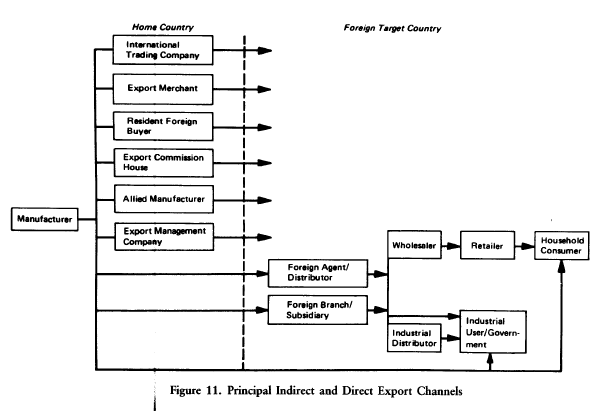To get its product into a foreign target market, a company can use any one of several export modes or channels. The principal export channels are depicted in Figure 11.

The key distinction among these alternative channels is the presence or absence of independent export agencies located in the home country. When a manufacturing firm uses domestic agencies, it does not undertake exporting on its own and has at most a marginal role in the foreign marketing of its product. That is why exporting through domestic intermediaries is called indirect exporting.
Indirect exporting may be a good way for a firm to enter foreign markets for the first time. But with the qualified exception of export management companies, indirect exporting does not allow a manufacturing firm to have its own international market entry strategy. Indirect exporting demands little, if any, foreign country/market knowledge on the part of the manufacturer, but, for the same reason, it insulates the manufacturer from foreign markets. Thus a company that wants active penetration of international markets will look to direct export channels. Since this book deals with international market entry strategies, we shall consider indirect exporting only in the final section of this chapter, where we address companies that have not yet entered international business.
Direct exporting offers several advantages to the manufacturer: (1) partial or full control over the foreign marketing plan (distribution, pricing, promotion, product services, and so on), (2) concentration of marketing effort on the manufacturer’s product line, (3) more and quicker information feedback from the target market, which can improve the marketing effort with, say, closer product adaptation or more responsive pricing, and (4) better protection of trademarks, patents, goodwill, and other intangible property. But these advantages can be realized only when the exporting firm assumes responsibility for the international marketing effort in carrying out its entry strategy.
Direct exporting also requires that the manufacturer learn the procedures and documentation of export shipments and international payments arrangements. Thus direct exporting has higher startup costs, greater information requirements, and higher risks than indirect exporting.
Direct exporting relies on two principal channels: the foreign agent/ distributor channel and the foreign branch/subsidiary channel.3 A third, less common, channel is direct contact between the manufacturer and final buyers in the target market, such as mail-order exporting and the use of company representatives working out of the home country. As Figure 11 indicates, a direct export channel is an element of the full marketing channel, and its selection, therefore, is both an entry mode decision and a marketing plan decision.
It is reasonable to regard the marketing channel in a foreign target country as an extension of a direct export channel. Accordingly, we define a direct export channel as the chain of marketing agencies that links a domestic manufacturing company to the final buyers (or users) of its product in the foreign target market. These agencies negotiate sales transactions, direct the physical movement and storage of the product, and provide other services in order to place the product ultimately in the ownership and possession of final buyers where, when, and in the quantities they want it. The foreign agencies participating in a direct export channel may be independent middlemen or owned by the manufacturer; they may be many or few in number. Since the first and last links in the direct export channel are the manufacturer and final buyers, respectively, it is logical to consider them also as channel elements. It is important for manufacturers to con-ceive the export channel as the full marketing channel rather than as a channel that stops with the foreign distributor or agent.
Foreign marketing agencies—agents, distributors, sales branches, sales subsidiaries, wholesalers, and retailers—are distinguished from facilitating agencies such as transportation companies, public warehouses, forwarders, customs brokers, banks, advertising agencies, consultants, and government agencies. Facilitating agencies provide services to the manufacturer that are necessary or helpful to the export process, but they do not engage in export sales transactions or control the marketing effort as do channel members.
Source: Root Franklin R. (1998), Entry Strategies for International Markets, Jossey-Bass; 2nd edition.

Some truly nice stuff on this website , I enjoy it.